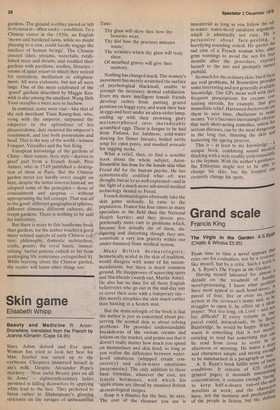Skin game
Elisabeth Whipp
Beauty and Medicine R. AronBrunetiere, translated from the French by Joanna Kilmartin (Cape £4.95) Since Adam delved and Eve span, Woman has tried to look her best for Man. Jezebel was tarted up to the eyebrows. Cleopatra immersed herself in ass's milk. Despite Alexander Pope's mockery 'Now awful Beauty puts on all its Arms' eighteenth-century ladies persisted in killing themselves by applying white lead to the face. They preferred to listen rather to Shakespeare's gloating strictures on the ravages of unbeauteous Thy glass will show thee how thy beauties wear, Thy dial how thy precious minutes waste; The wrinkles which thy glass will truly show, Of mouthed graves will give thee memory.
Nothing has changed much. The women's movement has merely scratched the surface of psychological blackmail, unable to attempt the necessary dermal exfoliation. Even my more intelligent female friends develop rashes from putting grated potatoes on baggy eyes, and wash their hair in eggs and beer under an ultra-violet lamp, ending up with their crowning glory metamorphosed into ineradicable scrambled eggs. There is fungus to be had from Finland, for baldness; cold-water sluicing for firmer breasts; boiled nettle soup for open pores, and mashed avocado for sagging necks.
What a relief, then, to find a sensible book about the whole subject. AronBrunetiere has done for the female skin what Freud did for the human psyche. He has systematically codified what oft was thought, but ne'er so well expressed -and in the light of a much more advanced medical technology denied to Freud.
French dermatologists obviously take the skin game seriously. In ratio to the population, France has four times as many specialists in the field than the National Health Service; and they devote proportionally more care to problems which, because few actually die of them, disfiguring and disturbing though they are, constitute a very low priority within our under-financed State medical system.
Many British dermatologists, hermetically sealed in the skin of tradition, would disagree with some of his recommendations, but there is much common ground. He disapproves of squeezing spots and blackheads (watch out, Martin Amis). He also has no time for all those English heliotropes who go out in the mid-day sun to cover their acne with a temporary tan this merely atrophies the skin much earlier than basking in a Scotch mist.
But the main strength of the book is that the author is just as concerned about preserving the normal skin as about solving problems. He provides understandable breakdowns of the various creams and lotions on the market, and points out that it doesn't really matter how much you spend on moisturisers and skin food, so long as you realise the difference between waterin-oil emulsions (whipped cream consistency) and oil-in-water emulsions (mayonnaise). The only addition to these basic formulae, whatever the cost, are female hormones, with which his applications are liberal by standard British dermatological recipes.
Soap is a disaster for the face, he says. The cost of the cleanser you use is immaterial as long as you follow the oilin-water: water-in-oil emulsion argument' which is admittedly not easy. He is persuasive about face-peeling, 2 horrifying-sounding ordeal. He quotes the sad case of a French woman who, after grim warnings to avoid the sun for four months after the procedure, exposed herself to the sun and promptly turned piebald. So much for the ordinary skin: but if there are real problems, M Brunetiere provides some interesting and not generally available knowledge. Our GPs mean well with the frequent prescriptions for creams taining steroids, for example, that re immediate relief. Harrassed doctors can use them to save time, charlatans to 111,alce money. Yet it becomes increasingly obvious that such short-acting remedies, unless for serious diseases, can be the most dangercnids in the long run, thinning the skin hastening the ageing process. This is at least to my knowledge a, unique book, combining sound medical thinking with a style readily understandable to the layman. With the author's guidance' the Ethiopian might not to be able t° change his skin; but the leopard On certainly change his spots.






































 Previous page
Previous page